After a flurry of emergency preparations that went on through the week, Hurricane Earl was downgraded to a tropical storm by the time it arrived on the Island late Friday night, sparing the Island any damage save from drenching rains that flooded some cellars and washed out driveways.
The storm was the second wettest to hit the Island since rainfall record-keeping began in 1946. Total rainfall at the National Weather Service station in Edgartown between approximately 9 p.m. Friday and 3 a.m. Saturday was 6.21 inches. That is nearly an inch an hour. Rainfall was not as heavy in other areas; Vineyard Haven recorded 3.9 inches of rain, and Nantucket, which was closest to the center of the storm, recorded 2.29 inches.
In 1972 tropical storm Carrie, which also arrived on Labor Day weekend, dumped 12.5 inches of rain on the Island over two days. Carrie was a much more severe storm, with hurricane-force winds. Peak wind gusts recorded on the Island during Earl were 44 miles per hour. Nantucket reported peak gusts of 54 miles per hour. Wind gusts were higher offshore.
Islanders were relieved to be spared a hurricane.
“The impact was not even as much as the last northeaster. We’re not complaining,” said Menemsha assistant harbor master Richard Steves after the storm had passed.
But there were plenty of complaints from residents and business owners about the fractured way communication was handled in advance of the storm. A new reverse-911 system called code red was tested for the first time. The system sends recorded telephone messages to residents, although not all Islanders received the messages. A state of emergency was declared late Thursday and an announcement was made early Friday that Island roads and businesses would be closed at 2 p.m. that day. But when 2 p.m. came Earl was still well south of the Island and there were no adverse weather conditions except at the beaches where the surf was high and swimming was hazardous. Steamship Authority ferries were still running (even though the Coast Guard had issued a Port Condition Zulu, ordering all ports closed in southeastern Massachusetts).
It turned out that the road closure was in fact a travel advisory. The advisory was extended to 8 p.m. in the middle of the afternoon when it was clear the storm was still well off the Island, but the correct information did not reach every town. In Edgartown streets were filled with pedestrians, and bars and restaurants were open, while in Oak Bluffs and Vineyard Haven business owners had been told by police to shut down. Even within towns, it varied; LeRoux at Home’s open doors welcomed a stream of customers while C.B. Stark was boarded up across the street (see separate story covering business reaction on this page).
Information was posted on some but not all town Web sites, as well as the two Island newspaper Web sites, but none of the information was consistent and public confusion was widespread.
Meanwhile, there was ample preparedness for the storm. Shelters were opened in Edgartown, Oak Bluffs, Tisbury, Chilmark and Aquinnah. And while few people needed shelter once the storm forecasts were downgraded, there were still a handful of takers in the down-Island towns.
“I like the accommodations,” said Robert Celusak, who stayed the night at the shelter in the Oak Bluffs School with his wife, Joan. They had one other person for company, and plenty for breakfast the next morning; the town had stocked enough potatoes, eggs, sausage and biscuits to feed 150 people. “We were ready,” said Jeannie Pierson, who was in charge of food preparation.
By Saturday morning the storm had passed and Islanders went about the business of taking down plywood shutters and returning potted plants to decks and porches.
Edgartown fire chief and town emergency manager Peter Shemeth agreed that some fine-tuning is in order, but in all he said the hurricane that didn’t happen provided an opportunity for a good emergency drill. “It’s always better to err on the side of caution,” Mr. Shemeth said.
This story was compiled from Gazette staff reports.





Comments
Comment policy »